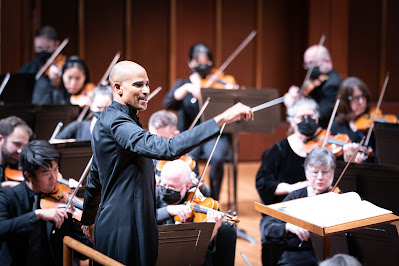Midsummer illuminations: ISO gives free classical concert at home
The welcome return of Kevin John Edusei to the Hilbert Circle Theatre podium Wednesday night was an extraordinary showcase for a guest conductor: a free concert presented by the Indianapolis Symphony Orchestra as a "thank you" to the public. Indoor classical concerts in the summer are rare in its schedule. The buzz grows that Edusei may be a favorite in the ISO's music-director search.
 |
| Kevin John Edusei conducted Stravinsky's third 'Firebird' suite Wednesday. |
In his third "Firebird" suite, Stravinsky bracingly sheds the late Romantic palette that he imbibed from the example of his compatriot and teacher Rimsky-Korsakov and made his own in the 1910 original ballet score. The orchestration has a modernist sheen; hints of the original ballet staging are muted. Chamber-music episodes come to the fore, and there are several horn solos besides the famous one, all of them played to pristine effect by ISO principal Robert Danforth.
And there was appropriately less heroism and more Apollonian straightforwardness in assistant bassoonist Mark Ortwein's playing of the "Lullaby" theme that in the ballet introduces the release of numerous creatures from an evil spell. In this version, the wedding processional music at the end launches with a series of separated, stabbing chords that contrast with the more grandiose passage in the 1911 suite. Though he never abandoned his patriotic admiration for Tchaikovsky, Stravinsky was far removed from romantic afflatus by 1945.
The concert opened with the third local representation of Anna Clyne's music within the past year. We heard "This Midnight Hour" last fall in concerts conducted by Carlos Kalmar, and the UK native's "Sound and Fury" was performed by the Indianapolis Chamber Orchestra a few months ago. The latter score sounds clearly its genesis in Shakespeare's "Macbeth," and literary associations are explicitly endorsed by the composers. In a video published by the ISO, she mentions a couple of poems that lie behind "This Midnight Hour." The work has nothing to do with soul singer Wilson Pickett's hit "The Midnight Hour": No love comes tumbling down in this evocation of a woman's running naked and alone through the night.
With "This Midnight Hour," the orchestra had the benefit of a second recent reading of a contemporary score under a different conductor. How often does that happen? No wonder the performance sounded so brilliantly assured. The explosive accents and the profusion of rushing figures, starting with the stomach-rumblings of the lower strings, couldn't have been more vivid than they were Wednesday night.
The entrance of a cinematically inclined waltz theme about halfway through the piece indicated that a dream world was making welcome intrusions into the woman's mad rush. Clyne is quite open about the sociability of her muse with other art and with its need to engage audiences and musicians. No wonder that she's made a connection in an environment that often casts a jaundiced eye at new music.
Reveling in different configurations of the orchestra, Edusei led a revealing performance of a symphony by the 18th-century Italian master of instrumental music, Luigi Boccherini. A cellist-composer whose most famous piece for his instrument has suffered editorial mayhem over the centuries, Boccherini in his Symphony No. 6 in D minor, with the fourth of his op. 12 set, displays a distinctive personality in a musical era dominated perpetually by three eminent Austrians.
Despite the abstract nature of symphonic music, this piece carries a distinct trace of Italian theatricality: There is a sobering, portentous, well-paced second movement that to me evoked the Two Armed Men from Mozart's "Magic Flute." There is almost a structural employment of crescendos, especially in the finale. Texturally, the variety included stunning highlighting of the cello section. Two horns, two oboes, and one bassoon supplemented reduced strings. Conducting without a baton, the German conductor made the most of shaping the music with his amazingly large, long-fingered hands.
 |
| ISO concertmaster Kevin Lin played enchanting Ravel. |
Concertmaster Kevin Lin had a deserved turn in the spotlight in Maurice Ravel's "Tzigane." The soloist's emphasis on the occasionally introspective side of gypsy music as the French composer conceived it was remarkably appropriate. It allowed him to fashion a full-spectrum interpretation of this perpetually exotic work. The soloist and the accompaniment Edusei guided formed a convincing whole, and the large audience was both charmed and thrilled by the performance.
[Edusei photo from July 13 concert by Nick Shotwell]



Comments
Post a Comment